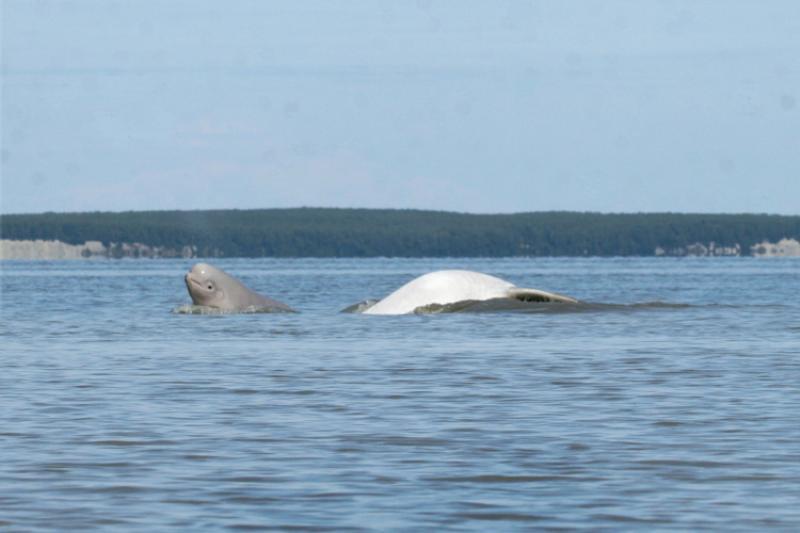
Public benefits of recovering endangered beluga whale outweigh costs
by NOAA Fisheries 9 Jul 2023 19:07 UTC

Cook Inlet beluga whales © Chris Garner, Joint Base Elmendorf–Richardson
The Cook Inlet beluga whale was listed as endangered in 2008, following a steep population decline. When the population failed to recover despite protection, NOAA Fisheries developed a comprehensive recovery plan.
"It is important to understand the tradeoffs in benefits and costs of recovery," said NOAA Fisheries economist Dan Lew, Alaska Fisheries Science Center. "The assessment of benefits and costs is required in federal regulatory analyses to ensure whether, and to what extent, the public will be better off because of this action. However, information on the benefits to recover threatened and endangered species is not commonly available and is not easily measured."
To fill this information need, Lew estimated the economic value of Cook Inlet beluga whale recovery based on survey responses from 1,747 Alaska households. He then compared these benefit estimates with the cost of recovery.
"When we extend the sample results to the population of all households, the benefits outweigh the costs. Alaskan households care about protecting and recovering this beluga population that is found only in their state," Lew said. "If we were to extend the results to include the entire nation, the net benefits would be even greater."
An urban whale
The Cook Inlet beluga whale is found exclusively in its namesake waters. Cook Inlet borders Anchorage—Alaska's most populous city, largest port, and center of commerce.
In 2008, the Cook Inlet beluga was listed as endangered due to persistent population declines over previous decades. Despite Endangered Species Act protections, the population failed to recover. Today scientists estimate that 331 animals remain, down from about 1,300 in 1979.
Potential causes of decline of ongoing concern include:
- Harmful noise from human activities
- Changes in prey abundance
- Potential catastrophic events like oil spills and mass strandings
- Pathogens and disease
- Habitat loss and degradation
In response, NOAA Fisheries adopted a comprehensive recovery plan for the Cook Inlet beluga in 2016. The plan outlines a 50-year strategy entailing research, monitoring, management, and public education and outreach. The estimated cumulative cost is $73 million (in 2013 dollars).
Weighing costs and benefits of recovery
To assess net benefits to the public, the study employed a stated preference discrete choice experiment. This involved surveying a random sample of Alaska households to collect data on their preferences for protecting the Cook Inlet beluga whale. Of the 4,200 randomly selected households that were mailed surveys, 1,747 returned completed surveys. The effective response rate was 44.4 percent.
This information reveals respondents' "willingness to pay," which is the maximum price that a customer is willing to pay for a product or service (in this case, beluga conservation). The data were analyzed using different models and assumptions about how to extend the sample results to the population of all households. The study then compared willingness-to-pay estimates for the population of households with the cost of recovery to see if the plan passed the benefit-cost test.
The preferred, state-of-the-art model showed that Alaska households are willing to pay $99 million for full recovery of Cook Inlet belugas, easily exceeding the $73 million costs. Other model estimates ranged from $34 million to $103 million (all values are in 2013 dollars).
"The Cook Inlet beluga is an isolated population, located only in Cook Inlet. It's in a state where people are close to the natural environment and surrounded by wildlife. And there are other beluga populations elsewhere. Despite all that, the public still expressed a desire to protect and recover it," Lew said. "I think that's important to understand. It indicates a public desire to protect other species that are not widespread in their range."
The survey was limited to Alaska due to requirements designed to avoid overly burdening the public. However, the Cook Inlet beluga is protected as a public resource of the United States. Previous nationwide research had found that protection of endangered Alaska species is valued beyond the state boundaries.
Public benefits of endangered species protection
This research expands our knowledge of public values for protecting threatened and endangered species. A previous study had shown that, even under restrictive assumptions, the benefits are greater than costs for 34 of 36 threatened and endangered species in the United States.
This study estimated that the mean household willingness-to-pay values for Cook Inlet beluga whale recovery ranged from $221 to $409. The preferred model estimate was $395. Values from other studies for the recovery of other threatened and endangered whale species, such as the humpback whale, Southern Resident killer whale, and the North Atlantic and North Pacific right whales, ranged from $487 to $674 per household. These values are the total amount households would be willing to pay for recovery now and in the future.
"Our results add another data point showing that protecting endangered species leads to positive net benefits to society," Lew said.
NOAA Fisheries has designated Cook Inlet belugas as one of nine "Species in the Spotlight." The initiative brings attention to and helps mobilize resources to recover species most highly at risk of extinction. In 2023, NOAA Fisheries celebrates the 50th anniversary of the Endangered Species Act, a major milestone for the conservation of protected species and their habitats